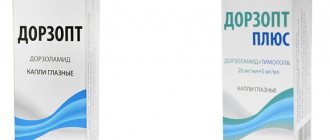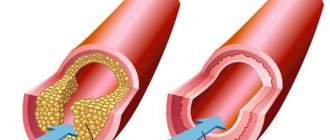Instructions for use ROSULIP® PLUS
Effect on skeletal muscles
In the post-registration period, cases of myopathy and rhabdomyolysis were observed with the use of ezetimibe. Cases of rhabdomyolysis have been reported in very rare cases both with ezetimibe monotherapy and when ezetimibe is added to other medicinal products associated with an increased risk of rhabdomyolysis. If myopathy is suspected (based on muscle symptoms or elevated CPK levels), ezetimibe, all statins, and any drugs known to be associated with an increased risk of rhabdomyolysis should be immediately discontinued. At the beginning of treatment, all patients should be instructed to promptly report any episodes of unexplained muscle pain, muscle soreness, or weakness.
Effect on the liver
In controlled studies, consistent increases in transaminases (≥3 times the ULN) were observed when ezetimibe and a statin were used together.
It is recommended to determine liver function 3 months after the start of rosuvastatin therapy. Rosuvastatin should be discontinued or its dose reduced if serum transaminase levels are 3 times higher than the ULN. The incidence of serious liver events (mainly increased transaminases) noted in the post-registration period is higher when taking rosuvastatin at a dose of 40 mg.
In patients with secondary hypercholesterolemia caused by hypothyroidism or nephrotic syndrome, treatment of the underlying disease is necessary before initiating therapy with Rozulip® Plus.
The effectiveness and safety of ezetimibe in patients with moderate or severe liver dysfunction have not been established, therefore the use of Rozulip® Plus in this category of patients is not recommended.
Effect on the kidneys
In patients treated with rosuvastatin at a dose of 40 mg, proteinuria was observed (determined by the express method), which was predominantly tubular in nature. In most cases, proteinuria was transient or inconsistent. Proteinuria has not been shown to be a symptom of acute or progressive kidney disease. The incidence of reports of serious renal events during post-marketing use is higher with rosuvastatin 40 mg. The need to monitor renal function (every 3 months or more frequently) should be considered when monitoring patients receiving rosuvastatin 40 mg.
Determination of CPK activity
CPK determination should not be performed after intense physical activity or if there are other probable reasons for the increase in CPK, which may complicate the interpretation of the results.
If there is a significant increase in CPK levels (>5 ULN), CPK measurements should be repeated after 5-7 days. If repeated measurements confirm that the CPK level is >5 ULN, treatment should not be started.
Fusidic acid
Rosulip® Plus tablets should not be used in conjunction with fusidic acid for systemic use or within 7 days after discontinuation of fusidic acid treatment. Patients prescribed fusidic acid treatment should discontinue rosuvastatin throughout the entire treatment period. Rhabdomyolysis has been reported in patients treated concomitantly with rosuvastatin and fusidic acid (in some cases fatal). (See Drug Interactions section). Patients should be informed of the need to immediately consult a doctor if muscle weakness, pain or tenderness develops.
Before starting treatment
Rozulip® Plus, like other HMG-CoA reductase inhibitors, should be prescribed with caution to patients with factors predisposing to the development of myopathy or rhabdomyolysis:
- renal failure;
- hypothyroidism;
- personal or family history of hereditary muscle diseases;
- toxic effects on muscles when using another HMG-CoA inhibitor or fibrate;
- alcohol abuse;
- age >70 years;
- situations in which increased levels of active substances in plasma are possible;
- simultaneous use of fibrates.
In such patients, it is necessary to assess the risk and possible benefits of treatment, and clinical monitoring is recommended. Treatment should not be started if there is a significant initial increase in CPK activity (>5 ULN).
During treatment
Patients should immediately report any unexplained muscle pain, weakness, or muscle spasms, especially if accompanied by general weakness or fever. In these patients, CPK levels should be determined. Treatment should be discontinued if there is a significant increase in CPK activity (>5 ULN) or in the presence of severe symptoms that cause daily discomfort (even with CPK levels ≤5 ULN). Routine CPK monitoring is not required in asymptomatic patients.
There are very rare reports of the development of immune-mediated necrotizing myopathy during or after treatment with statins, incl. rosuvastatin. Clinically, this disease is characterized by proximal muscle weakness and elevated serum CPK that persists despite statin discontinuation.
In clinical studies, there was no evidence of increased effects on skeletal muscles in a small number of patients concomitantly taking rosuvastatin and other lipid-lowering drugs. An increased incidence of myositis and myopathy was observed in patients concomitantly taking other HMG-CoA reductase inhibitors and fibric acid derivatives (including gemfibrozil), cyclosporine, nicotinic acid, azole antifungals, protease inhibitors or macrolide antibiotics. Gemfibrozil increases the risk of myopathy when taken together with certain HMG-CoA reductase inhibitors, therefore the combination of Rozulip® Plus and gemfibrozil is not recommended. The benefits of further lipid reduction when taking Rosulip® Plus in combination with fibrates or niacin should be carefully weighed against the possible risks of using this combination of drugs. Rosuvastatin at a dose of 40 mg is contraindicated while taking fibrates.
Rozulip® Plus should not be used in patients with serious acute conditions that are likely to have myopathy or that predispose to the development of renal failure due to rhabdomyolysis (for example, sepsis, hypotension, major surgery, trauma, severe metabolic, endocrine or electrolyte balance, with uncontrolled seizures).
Patient race
Pharmacokinetic studies of rosuvastatin have shown increased drug exposure in Mongoloid patients compared to Caucasian patients.
Protease inhibitors
Increased systemic exposure to rosuvastatin was observed in patients concomitantly taking rosuvastatin and various protease inhibitors in combination with ritonavir. Consideration should be given to both the lipid-lowering benefits of Rosulip Plus in HIV-infected patients receiving protease inhibitors and the possibility of increased rosuvastatin plasma concentrations at initiation and during dose titration of rosuvastatin. The combined use of the drug with some protease inhibitors is recommended only with dose adjustment of Rozulip® Plus.
Interstitial lung diseases
In exceptional cases, the development of interstitial lung diseases has been reported with some statins, especially with long-term therapy. Symptoms of such diseases include a nonproductive cough and deterioration in general health (fatigue, weight loss, and fever). If a patient is suspected of developing interstitial lung disease, statin therapy should be discontinued.
Diabetes
Some data suggest that drugs of the statin class increase blood glucose levels and, in some patients at high risk of developing diabetes mellitus, may lead to hyperglycemia, the level of which meets the formal definition of diabetes mellitus and requires the initiation of hypoglycemic therapy. This risk, however, is outweighed by the reduction in vascular risk with statins and should therefore not be a reason to discontinue statin therapy. In patients at risk (fasting glucose level 5.6-6.9 µmol/l, BMI >30 kg/m2, increased triglycerides, arterial hypertension), clinical and biochemical monitoring of diabetes mellitus should be carried out in accordance with national guidelines.
In the JUPITER study, the overall incidence of diabetes mellitus was reported to be 2.8% in the rosuvastatin group and 2.3% in the placebo group (primarily in patients with fasting glucose levels of 5.6-6.9 mmol/L).
Fibrates
The safety and effectiveness of coadministration of ezetimibe and fibrates have not been established. If cholestasis is suspected in a patient receiving Rosulip® Plus and fenofibrate, the gallbladder should be examined and this therapy should be discontinued.
Anticoagulants
If Rozulip® Plus is added to therapy with warfarin, other coumarin anticoagulants or fluindione, appropriate INR monitoring is required.
Liver disease and alcohol use
Rozulip® Plus should be used with caution in patients with excessive alcohol consumption and/or a history of liver disease.
Use in pediatrics
The safety and effectiveness of Rozulip® Plus in patients under 18 years of age have not been established, therefore the use of the drug in this age group is not recommended.
Cyclosporine
:
- see sections Contraindications and Drug interactions.
Impact on the ability to drive vehicles and operate machinery
Rozulip® Plus does not affect or has a negligible effect on the ability to drive vehicles and operate machinery. No studies have been conducted on the effect of rosuvastatin and/or ezetimibe on this ability. However, when driving vehicles or operating machinery, the risk of dizziness that may develop during treatment should be taken into account.
Preclinical data
In studies with coadministration of ezetimibe and statins, the toxic effects observed were consistent with those typically associated with statin administration. Some toxic effects were more pronounced compared with the administration of statins alone, which is associated with pharmacokinetic and pharmacodynamic interactions with both drugs. There was no such interaction in clinical studies. Myopathies developed in rats only when exposed to doses several times the human therapeutic dose (approximately 20 times the AUC for statins and 500 to 2000 times the AUC for active metabolites).
Ezetimibe (±statins) showed no potential genotoxicity in a range of in vivo
and
in vitro
. Ezetimibe has not been shown to be carcinogenic in long-term studies.
Concomitant administration of ezetimibe and statins did not have a teratogenic effect in rabbits. In the offspring of pregnant rabbits, a small number of skeletal deformities were noted (fusion of the thoracic and caudal vertebrae, reduction in the number of caudal vertebrae).
Rosuvastatin:
Based on preclinical data from standard pharmacological studies of safety, possible genotoxicity and carcinogenicity, no particular danger to humans has been shown. Specific studies of the effect on the hERG protein have not been carried out. Adverse reactions not noted in clinical studies, but observed in animals in which drug concentrations were similar to those in clinical use, were as follows: in repeated dose toxicity studies, liver histopathological changes, probably caused by the pharmacological action of rosuvastatin (in mice and rats), and (to a lesser extent) changes in the gallbladder (in dogs, but not in monkeys). In addition, toxic effects on the testes were observed in monkeys and dogs when used in higher doses. Clear reproductive toxicity has been observed in rats:
- when administered in doses toxic to the mother, a decrease in litter size, litter weight and survival rate of rat pups was observed. Systemic exposure was several times higher than therapeutic concentrations.
Ezetimibe:
Toxicity studies of ezetimibe in animals with long-term use did not reveal target organ toxicity of ezetimibe. In dogs treated with ezetimibe for 4 weeks (≥0.03 mg/kg/day), the concentration of cholesterol in gallbladder bile increased 2.5-3.5 times. However, in a study in dogs that received ezetimibe at doses up to 300 mg/kg/day for 1 year, there was no increase in the incidence of cholestasis or other changes in the liver and biliary tract. The significance of these data for humans is unknown. It cannot be excluded that the therapeutic use of ezetimibe is associated with a risk of developing cholelithiasis.
Ezetimibe did not affect fertility in male or female rats, was not teratogenic in rats or rabbits, and did not affect pre- or postnatal development. Ezetimibe crossed the placental barrier in pregnant rats and rabbits after repeated administration of doses equal to 1000 mg/kg/day. Concomitant administration of ezetimibe and lovastatin resulted in embryo death.
Rozulip plus, 20mg+10mg, capsules, 30 pcs.
When using the drug Rozulip® at a dose of 40 mg, it is recommended to monitor kidney function indicators.
When using the drug Rozulip® in all doses, especially more than 20 mg, the development of myalgia, myopathy and, in rare cases, rhabdomyolysis has been reported.
Determination of CPK activity should not be carried out after intense physical activity or in the presence of other possible reasons for increased CPK activity, which may lead to incorrect interpretation of the results obtained. If the initial CPK activity is significantly increased (5 times higher than ULN), a repeat measurement should be taken after 5–7 days. Therapy should not be started if a repeat test confirms increased CPK activity (5 times the ULN).
When prescribing Rozulip® (as well as other HMG-CoA reductase inhibitors) in patients with existing risk factors for rhabdomyolysis, it is necessary to consider the ratio of expected benefits and potential risks and conduct clinical monitoring.
The patient should be informed to immediately report to the doctor the unexpected onset of muscle pain, muscle weakness or cramps, especially in combination with malaise and fever. In such patients, CPK activity should be determined. Therapy should be discontinued if CPK activity is significantly increased (more than 5 times compared to ULN) or muscle symptoms are severe and cause daily discomfort (even if CPK activity is 5 times less than ULN). If symptoms disappear and CPK activity returns to normal, re-prescribing Rozulip® or other HMG-CoA reductase inhibitors in lower doses should be considered with careful monitoring of the patient.
Routine monitoring of CPK activity in the absence of symptoms is impractical.
There were no signs of increased toxic effects on skeletal muscles when using the drug Rozulip® as part of combination therapy. An increase in the number of cases of myositis and myopathy has been reported in patients taking other HMG-CoA reductase inhibitors in combination with fibric acid derivatives (including gemfibrozil), cyclosporine, nicotinic acid in lipid-lowering doses (more than 1 g / day), azole antifungals, inhibitors proteases and macrolide antibiotics. Gemfibrozil increases the risk of myopathy when administered concomitantly with certain HMG-CoA reductase inhibitors. Thus, simultaneous administration of Rozulip® and gemfibrozil is not recommended. The ratio of expected benefits and potential risks should be carefully weighed when using Rozulip® together with fibrates or nicotinic acid in lipid-lowering doses (more than 1 g/day).
2-4 weeks after the start of treatment and/or when increasing the dose of Rozulip®, monitoring of lipid metabolism parameters is necessary (dosage adjustment is required if necessary).
It is recommended to determine transaminase activity before starting therapy and 3 months after starting therapy. Taking Rozulip® should be stopped or the dose reduced if the activity of transaminases in the blood serum is 3 times higher than the ULN.
In patients with hypercholesterolemia due to hypothyroidism or nephrotic syndrome, treatment of underlying diseases should be carried out before starting treatment with Rozulip®.
There is no clinical experience and data on the use of the drug in patients with liver dysfunction exceeding 9 points on the Child-Pugh scale.
Very rare cases of interstitial lung disease have been reported in patients receiving certain statin drugs. Typically, these cases were observed during long-term statin therapy. Interstitial lung disease is characterized by shortness of breath, nonproductive cough, and deterioration of general condition (fatigue, weight loss, and fever). If interstitial lung disease is suspected, statin therapy should be discontinued.
The results of pharmacokinetic studies indicate that in Asian patients the bioavailability of rosuvastatin is higher than in Europeans.
This drug should not be taken by patients with lactose intolerance, lactase deficiency or glucose-galactose malabsorption, because the drug contains lactose.
Use in pediatrics
The effectiveness and safety of the drug in children under 18 years of age have not been established. Experience with the drug in pediatric practice is limited to a small number of children (8 years of age and older) with familial homozygous hypercholesterolemia. Currently, it is not recommended to use Rozulip® in children.
Impact on the ability to drive vehicles and operate machinery.
Patients should be careful when driving vehicles and work that requires increased concentration and speed of psychomotor reactions, because Dizziness may occur during therapy.



